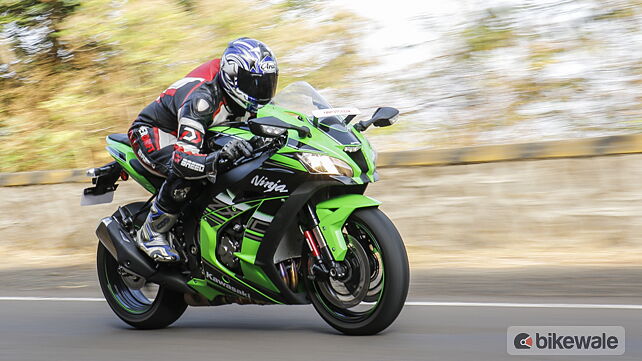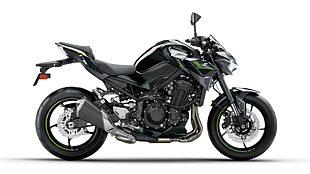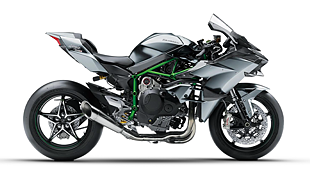What is it?

How does it ride?

It’s terrific! So good, so well sorted, so well engineered and so smart, it tricks you into believing that you have actually acquired the riding skills you have been dreaming about all this while, overnight. That front-end has so much grip and feedback, the chassis is so responsive, and the turning ability of the ZX-10R just allows you to be a lot more committed around a bend.

And here’s the sweet bit: You might think that you are entering a corner too hot on the 10R, but there’s always room to tighten the line. There’s enough cornering clearance and the way the front – the tyre, the suspension and even the brakes for that matter – communicates the endless levels of grip available, just soothes you into making a corner without panic or stress levels shooting through the helmet. The bike simply shrinks around you, and the faster you go, the better it gets! And lest I forget, this is one of the few big, fast, and racy motorcycles that doesn’t get dramatically upset by mid corner bumps, further adding to the rider’s confidence.
All of this is made possible courtesy the changes that have been brought to the 2016 Ninja ZX-10R compared to the older model. It now gets balance free front forks (BFF), a revised chassis and swingarm, and a new steering geometry. The new forks use gas charging for more consistent feel and discerning adjustment; the chassis is lighter and the swingarm longer for both added agility and stability; and the geometry now with the steering head closer to the rider, is supposed to add to the bike’s flick-ability. And flick-able it most certainly is.

And of course, if it’s a litre-class supersports, handling is only part of the menu; equally important is the engine and electronics that govern its performance. For 2016, Kawasaki has revised the engine. The liquid cooled, inline four still runs the same bore and stroke and with it an identical 998cc, but the internals have been heavily reworked. The new engine gets a lighter balancer shaft, newly designed cylinder heads, a revised combustion chamber design, lighter pistons and titanium alloy headers.
What this means is that when you aren’t in a tearing hurry, the ZX-10R can be pretty docile. Upshift early and even if you don’t have a great right wrist, the bike won’t take off from under you or spit you under oncoming traffic. It pulls cleanly even from 3,000rpm and you can get to 6th gear even before you hit 100kmph. And it remains ride-able throughout. It does heat up in slow moving traffic though.

But, when the yellow lights on the tachometer turn red (read 8,000rpm), the Ninja ZX-10R turns savage. There’s the typical inline four scream with an underlying note of violence that can scare the wits off bystanders, animals and even the rider himself. Actually, the ZX-10R’s performance – if you call upon it as its makers intended by riding it only in the red zone – can comfortably put the fear of god in you. It certainly scared me. It just charges ahead with such unrelenting rage, within seconds, you are out of road and equally out of options but to get hard on the brakes. And pray. Thankfully, the brakes are equally powerful and you are down to survival pace in no time.
Anything else I should know?

As with any litre-class supersport, the Kawasaki Ninja ZX-10R comes with a heavy dose of electronics. So much so that Kawasaki has split it into different headers. Under Power Technology, there’s the IMU, launch control, engine brake control, quick shifter, and power modes - F (Full) gives you 100 per cent, M (Middle) limits the power to 80 per cent, and L (low) cuts it down to 60 per cent.
Under Handling Technology, the IMU makes reappearance along with traction control, intelligent ABS, cornering management and an electronic steering damper.
For a more detailed understanding of these technologies, head here.

Should I buy one?

Where does it fit in?

The 2016 Kawasaki Ninja ZX-10R retails for Rs 18.2 lakh on the road in Mumbai. Its competition includes the Yamaha R1, which at Rs 26.9 lakh is quite pricey. The Honda CBR1000RR is bit more affordable (compared to the Yamaha) at Rs 20.3 lakh while the Suzuki GSXR1000 is almost at par with the Ninja at Rs 18.9 lakh. These are hardcore too, and almost equally track friendly and city phobic. There’s also the likes of the Aprilia RSV4 Factory and the Ducati 1299 Panigale that you might want to consider. However, you better have deep pockets for both these Italians are eye-wateringly expensive.
Gallery
1/50
Double Tap to Zoom
























![Kawasaki Ninja ZX-10R [2018-2019] Image Kawasaki Ninja ZX-10R [2018-2019] Image](https://imgd.aeplcdn.com/272x153/bw/models/kawasaki-ninja-zx-10r.jpg?20190103151915&q=80)























![KTM 390 Adventure X [2025] KTM 390 Adventure X [2025]](https://imgd.aeplcdn.com/272x153/n/cw/ec/190885/390-adventure-x-2025-right-side-view.jpeg?isig=0&q=80)